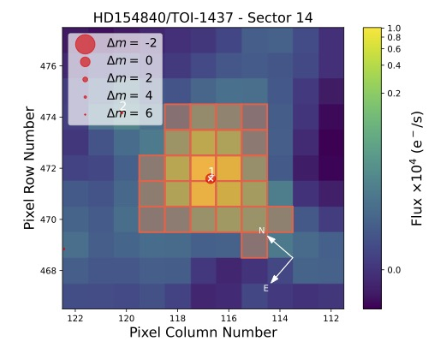2024-05-23 カリフォルニア大学リバーサイド校(UCR)
<関連情報>
- https://news.ucr.edu/articles/2024/05/23/international-planet-hunters-unveil-massive-catalog-strange-worlds
- https://iopscience.iop.org/article/10.3847/1538-4365/ad4484
- https://iopscience.iop.org/article/10.3847/1538-3881/ad2765
- https://arxiv.org/abs/2405.12448
TESS-ケック調査 XX。15の新しいTESS惑星と全サーベイターゲットの均一RV分析 The TESS-Keck Survey. XX. 15 New TESS Planets and a Uniform RV Analysis of All Survey Targets
Alex S. Polanski, Jack Lubin, Corey Beard, Joseph M. Akana Murphy, Ryan Rubenzahl, Michelle L. Hill, Ian J. M. Crossfield, Ashley Chontos, Paul Robertson, Howard Isaacson,…
The Astrophysical Journal Supplement Series Published 2024 May 23
DOI:10.3847/1538-4365/ad4484

Abstract
The Transiting Exoplanet Survey Satellite (TESS) has discovered hundreds of new worlds, with TESS planet candidates now outnumbering the total number of confirmed planets from Kepler. Owing to differences in survey design, TESS continues to provide planets that are better suited for subsequent follow-up studies, including mass measurement through radial velocity (RV) observations, compared to Kepler targets. In this work, we present the TESS-Keck Survey’s (TKS) Mass Catalog: a uniform analysis of all TKS RV survey data that has resulted in mass constraints for 126 planets and candidate signals. This includes 58 mass measurements that have reached ≥5σ precision. We confirm or validate 32 new planets from the TESS mission either by significant mass measurement (15) or statistical validation (17), and we find no evidence of likely false positives among our entire sample. This work also serves as a data release for all previously unpublished TKS survey data, including 9,204 RV measurements and associated activity indicators over our three-year survey. We took the opportunity to assess the performance of our survey and found that we achieved many of our goals, including measuring the mass of 38 small (<4 R⊕) planets, nearly achieving the TESS mission’s basic science requirement. In addition, we evaluated the performance of the Automated Planet Finder as survey support and observed meaningful constraints on system parameters, due to its more uniform phase coverage. Finally, we compared our measured masses to those predicted by commonly used mass–radius relations and investigated evidence of systematic bias.
TESS-Keckサーベイ。XIX. 暖かい土星質量の惑星と、太陽系アナログ軌道を周回する土星質量の惑星 The TESS–Keck Survey. XIX. A Warm Transiting Sub-Saturn-mass Planet and a Nontransiting Saturn-mass Planet Orbiting a Solar Analog
Michelle L. Hil, Stephen R. Kane, Paul A. Dalba, Mason MacDougall, Tara Fetherolf, Zhexing Li, Daria Pidhorodetska, Natalie M. Batalha, Ian J. M. Crossfield, Courtney Dressing,…
The Astronomical Journal Published 2024 March 13
DOI:10.3847/1538-3881/ad2765

Abstract
The Transiting Exoplanet Survey Satellite (TESS) continues to increase dramatically the number of known transiting exoplanets, and is optimal for monitoring bright stars amenable to radial velocity (RV) and atmospheric follow-up observations. TOI-1386 is a solar-type (G5V) star that was detected via TESS photometry to exhibit transit signatures in three sectors with a period of 25.84 days. We conducted follow-up RV observations using Keck/High Resolution Echelle Spectrometer (HIRES) as part of the TESS–Keck Survey, collecting 64 RV measurements of TOI-1386 with the HIRES spectrograph over 2.5 yr. Our combined fit of the TOI-1386 photometry and RV data confirm the planetary nature of the detected TESS signal, and provide a mass and radius for planet b of 0.148 ± 0.019 MJ and 0.540 ± 0.017 RJ, respectively, marking TOI-1386 b as a warm sub-Saturn planet. Our RV data further reveal an additional outer companion, TOI-1386 c, with an estimated orbital period of 227.6 days and a minimum mass of 0.309 ± 0.038 MJ. The dynamical modeling of the system shows that the measured system architecture is long-term stable, although there may be substantial eccentricity oscillations of the inner planet due to the dynamical influence of the outer planet.
TESS-Keckサーベイ XXII. TOI-1437を周回するサブ海王星 The TESS-Keck Survey. XXII. A sub-Neptune Orbiting TOI-1437
Daria Pidhorodetska, Stephen R. Kane, Emily A. Gilbert, Thomas Barclay, Alex S. Polanski, Michelle L. Hill, Keivan G. Stassun, Steven Giacalone, David R. Ciardi, Andrew W. Boyle, Steve B. Howell, Jorge Lillo-Box, Mason G. MacDougall, Tara Fetherolf, Natalie M. Batalha, Ian J. M. Crossfield, Courtney Dressing, Benjamin Fulton, Andrew W. Howard, Daniel Huber, Howard Isaacson, Erik A. Petigura, Paul Robertson, Lauren M. Weiss, Isabel Angelo, Corey Beard, Aida Behmard, Sarah Blunt, Casey L. Brinkman, Ashley Chontos, Fei Dai, Paul A. Dalba, Rae Holcomb, Jack Lubin, Andrew W. Mayo, Joseph M. Akana Murphy, Malena Rice, Ryan Rubenzahl, Nicholas Scarsdale, Emma V. Turtelboom, Dakotah Tyler, Judah Van Zandt, Edward W. Schwieterman
arXiv Submitted on 21 May 2024
DOI:https://doi.org/10.48550/arXiv.2405.12448

Abstract
Exoplanet discoveries have revealed a dramatic diversity of planet sizes across a vast array of orbital architectures. Sub-Neptunes are of particular interest; due to their absence in our own solar system, we rely on demographics of exoplanets to better understand their bulk composition and formation scenarios. Here, we present the discovery and characterization of TOI-1437 b, a sub-Neptune with a 18.84 day orbit around a near-Solar analog (Mstar = 1.10 +/- 0.10 Msun, Rstar = 1.17 +/- 0.12 Rsun). The planet was detected using photometric data from the Transiting Exoplanet Survey Satellite (TESS) mission and radial velocity follow-up observations were carried out as a part of the TESS-Keck Survey (TKS) using both the HIRES instrument at Keck Observatory and the Levy Spectrograph on the Automated Planet Finder (APF) telescope. A combined analysis of these data reveal a planet radius of Rp = 2.24 +/- 0.23 Rearth and a mass measurement of Mp = 9.6 +/- 3.9 Mearth). TOI-1437 b is one of few (~50) known transiting sub-Neptunes orbiting a solar-mass star that has a radial velocity mass measurement. As the formation pathway of these worlds remains an unanswered question, the precise mass characterization of TOI-1437 b may provide further insight into this class of planet.


